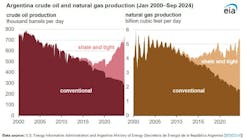Argentina hydrocarbon production nears record highs
Crude oil and natural gas production in Argentina are both nearing record highs, driven by increasing output from Vaca Muerta shale formation, which is offsetting declining output from conventional oil and natural gas fields.
From January 2021 through September 2024, crude oil production in Argentina increased by 50%, and natural gas production rose by 27%, lifting output of both fuels to near the records set in the early 2000s, according to data from the country’s energy ministry, the Secretaría de Energía de la República Argentina (SESCO), as reported by the US Energy Information Administration (EIA).
The US agency estimated that Vaca Muerta, located mainly in Argentina’s Neuquén province, has 308 tcf of technically recoverable shale gas resources and 16 billion bbk of technically recoverable shale oil and condensate resources. Argentina ranks among the world’s top five holders of shale crude oil and natural gas resources. Only Russia, the US, and China have larger shale crude resources, and only China more shale gas, according to EIA estimates.
In September 2024, overall crude production averaged 738,000 b/d in Argentina, 15% more than in September 2023 and the most in any month since 2003. Oil produced that month in Vaca Muerta accounted for 58% of the country’s total output, according to SESCO.
An average of 5 bcfd of natural gas was produced in Argentina over the first 9 months of 2024, 5.2% more than the same period in 2023. In August, natural gas production averaged 5.4 bcfd, the most for any month in 21 years. Vaca Muerta accounts for more than 70% of Argentina’s natural gas production, reaching 74% (3.8 bcfd) in September 2024.
Exports
Rising Vaca Muerta production has increased export opportunities for both fuels. Argentina’s crude oil exports increased by an average of 33% per year from 30,000 b/d in 2017 to 128,000 b/d in 2023. Shale crude oil accounted for about 70% of crude oil exported in 2023. Argentina's primary destinations for crude oil exports in 2023 were the US, Brazil, and Chile. The October 2024 completion of the 160,000-b/d Vaca Muerta Norte oil pipeline helped facilitate exports to Chile.
Growing domestic natural gas production and the development of several new pipeline projects have decreased Argentina’s LNG imports and led to planning to increase exports. Argentina relied on LNG imports to help manage peak heating and electricity demand during the southern-hemisphere winter (June-August). During the first 9 months of 2024, Argentina imported LNG equivalent to 200 MMcfd of natural gas, 43% less than the same period a year earlier.
Argentina’s natural gas imports via pipeline fell 47% in the first 9 months of 2024 compared with the same period in 2023, as pipeline imports from Bolivia, which made up around half of Argentina’s natural gas imports in 2023, came to an end. Meanwhile, Argentina is investing in infrastructure to expand the distribution of natural gas from the Vaca Muerta formation to northern Argentina, including reversing pipelines designed for imports from Bolivia to instead export natural gas to Brazil.
Natural gas exports to neighboring Chile and Uruguay via pipeline have increased, while Argentina’s LNG imports have declined due to new projects such as the 700-MMcfd Perito Francisco Pascasio Moreno gas pipeline (formerly Presidente Néstor Kirchner gas pipeline), which started operations last year, transporting natural gas from the Vaca Muerta formation north to the Santa Fe and Buenos Aires provinces (OGJ Online, July 7, 2023). Exports to Chile increased 14% in the first 9 months of 2024 compared with the same period last year, to about 250 MMcfd, according to EIA.
Infrastructure development
Several infrastructure projects are supporting growth in natural gas production from the Vaca Muerta region, including Perito Francisco Pascasio Moreno, on which a planned second phase would expand its capacity to 1.2 bcfd by 2028. The Gasoducto Norte pipeline is undergoing a flow reversal to transport natural gas from southern to northern Argentina. The first phase of operations began last month (OGJ Online, Nov. 11, 2024), with the pipeline expected to reach its full 700-MMcfd capacity first-quarter 2025, exporting gas to northern Chile and Brazil.
Several companies are LNG plants for the coming years. Golar LNG has a 20-year agreement with Pan American Energy (PAE) to deploy the Hilli Episeyo floating LNG (FLNG) plant in Argentina by 2027, targeting a production capacity of 2.45 million tonnes/year (tpy). Harbour Energy PLC has also joined this project (OGJ Online, Dec. 4, 2024).
Tecpetrol SA is designing a modular onshore plant with an initial capacity of 4 million tpy. YPF SA, Argentina’s state-controlled energy company, plans to bring an existing FLNG plant online by 2027, aiming for 1-2 million tpy of additional export capacity. It is also seeking new investors for a 5-million tpy LNG export project in Rio Negro, despite uncertainties regarding Petronas's involvement and significant infrastructure costs, EIA said.
